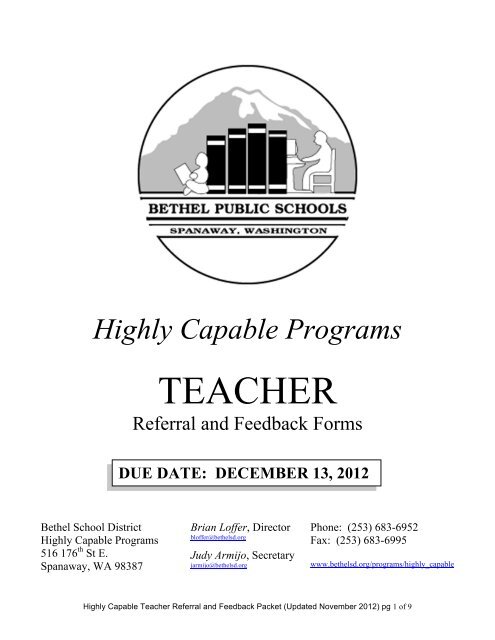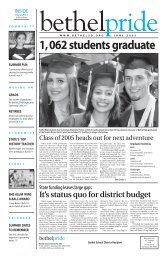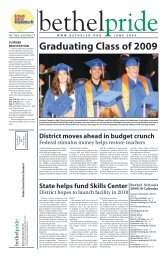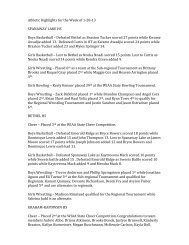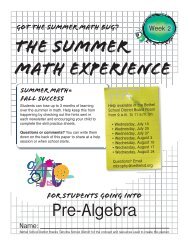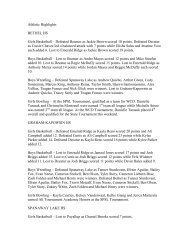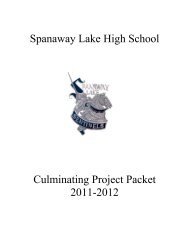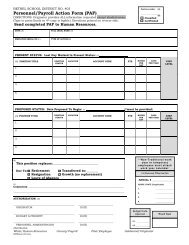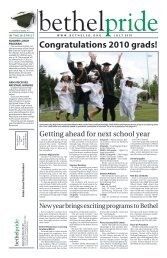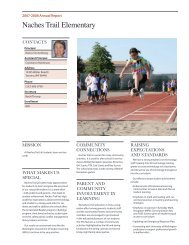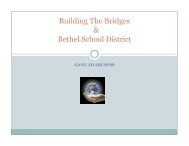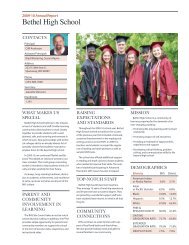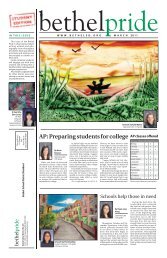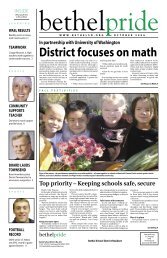Teacher Referral & Feedback Form - Bethel School District
Teacher Referral & Feedback Form - Bethel School District
Teacher Referral & Feedback Form - Bethel School District
You also want an ePaper? Increase the reach of your titles
YUMPU automatically turns print PDFs into web optimized ePapers that Google loves.
ANALYTICAL THINKING: (Demonstrates an ability to discern components of a whole. The student may notbe “organized”, yet enjoys organizing and planning events and procedures.) Some possible behaviors mayinclude: analyzes classroom tasks; is unusually attentive to details in environment; sees cause and effectrelationships; takes apart and reassembles things and/or ideas with unusual skill; expresses relationships betweenpast/present experiences; makes up or expands songs, stories, and riddles about learning experiences; organizescollections of things.Names of students who come to mind are: ______________________________________________________________________________________________________________________________________MEANING MOTIVATED: (Shows curiosity and an inner drive for thorough, independent understanding.)Some possible behaviors may include: keeps at an issue until it makes sense; asks penetrating questions; iscurious, asks how, why and what if; displays unexpected depth of knowledge in one or more areas; asks questionsabout words (in print or oral language); remembers; has accelerated task commitment and energy when learning;wants to do things on own; independent.Names of students who come to mind are: ______________________________________________________________________________________________________________________________________PERSPECTIVE: (Displays an ability to understand and incorporate unexpected or unusual points of view throughoral language, writing, manipulative, and/or art.) Some possible behaviors may include: see another’s point ofview; unexpectedly demonstrated dimension angle or perspective in art; creates interesting shapes or patterns; seesthe “big picture” in a variety of situations:Names of students who come to mind are: __________________________________________________________________________________________________________________________________SENSE OF HUMOR: (Demonstrates understanding of higher levels of humor and application of a finelydeveloped since of humor.) Some possible behaviors may include: says or does something indicating a finelydeveloped sense of humor; catches and adult’s subtle humor, uses figurative language for humorous effect;understand and uses puns and riddles; “plays” with language.Names of students who come to mind are: ______________________________________________________________________________________________________________________________________SENSITIVITY: (Intensely sensitive to the needs and motivation of others.) Some possible behaviors mayinclude: spontaneously takes action to help someone in need; uses empathic statements; has a strong sense ofjustice; has high expectations of self and others.Names of students who come to mind are: ______________________________________________________________________________________________________________________________________ACCELERATED LEARNING: (Demonstrates mastery and an ability to learn and understand material andconcepts beyond the facts and knowledge typical and expected for that age group.) Some possible behaviors mayinclude: rapidly accelerates learning after onset; categorizes by more than one attribute; has unusual ability tocomprehend symbols (musical, numeral, alphabet, maps); reads consecutive passages at an advanced reading leveland explains meaning of what is read; has unexpected mastery of numbers has unexpected understanding ofmathematical concepts; understands relationships of coin denominations.Names of students who come to mind are: ______________________________________________________________________________________________________________________________________--CONTINUE ON TO NEXT PAGE –Highly Capable <strong>Teacher</strong> <strong>Referral</strong> and <strong>Feedback</strong> Packet (Updated November 2012) pg 3 of 9
Look over the names of the students you have listed in the previous two pages. Is there a name whichappears in more than one category? Consider if this might be a student(s) who is highly capable and shouldbe referred for testing. Next, review the “Characteristics of Gifted Children” below.Characteristics of Gifted ChildrenSTEP TWO: Think about the students that you listed from STEP ONE. Look at the followingdescriptors of Gifted Learners / Highly Capable Learners. Identify which of your students should bereferred for highly capable programs.“Bright Child vs. Gifted Learner”Observing gifted characteristics is often difficult when we are dealing with obviously bright children.The chart below is helpful in seeing the subtle differences between the bright child and the gifted learner.Bright ChildGifted LearnerKnows the answersAsks the questionsIs interestedIs highly curiousIs attentiveIs mentally and physically involvedAnswers the questionsDiscusses in detail, elaborates.Top groupBeyond the groupListens with interestShows strong feelings and opinionsLearns with easeAlready knows6-8 repetitions for mastery 1-2 repetitions for masteryUnderstands ideasConstructs abstractionsEnjoys peersPrefers adultsGrasps the meaningDraws inferencesIs receptiveIs intenseCopies accuratelyCreates a new designEnjoys schoolEnjoys learningAbsorbs informationManipulates informationTechnicianInventorGood memorizerGood guesserEnjoys straightforward, sequential presentation Thrives on observantIs alert.Is keenly observantIs pleased with own learningIs highly self-criticalWHAT DOES HIGHLYCAPABLE MEAN?Being Highly Capable means havingextraordinary ability or potential in intellect,academic aptitude or creative thinking.Some examples include:• advanced vocabulary• curiosity (asks endless questions)• sophisticated sense of humor• experiments with ideas• advanced creativity• perfectionistHighly Capable <strong>Teacher</strong> <strong>Referral</strong> and <strong>Feedback</strong> Packet (Updated November 2012) pg 4 of 9
STEP THREE: Complete the <strong>Teacher</strong> <strong>Referral</strong> & <strong>Feedback</strong> <strong>Form</strong> for each student that you are referringor that has been referred by another person. (Note: One copy of the <strong>Teacher</strong> <strong>Referral</strong> & <strong>Feedback</strong> <strong>Form</strong>is attached. More are available in your office or online at http://www.bethelsd.org/programs/highly_capable.)Completed forms are due to <strong>School</strong> Office / Coordinator by December 13, 2012.Assessments & Selection ProcessTo qualify for highly capable programs, the following assessments are used:• Ability test scores: Cognitive Abilities Test (CogAT)Qualifying students score in the 97 th percentile or above in at least one testing area or students score in the 90 thpercentile in both Verbal and Quantitative tests. The CogAT tests are separated into three batteries: Verbal,Quantitative and Non-Verbal. For more information about the tests visithttp://www.riversidepublishing.com/products/cogAt/details.html#tests.• Achievement test scores.o Grades K-2: DIBELS, DIBELS Math, Easy CBM, and/or <strong>District</strong> Benchmark Assessments are examined.o Grades 3-8: MAP and MSP are examined. Students must have met or exceeded standard on the state tests.• Creativity. Creativity is assessed via the Renzulli-Hartman scale that is completed as part of the teacher feedbackform.A multi-disciplinary team consisting of teachers, district administrator, and psychologist/other qualified practitioner trained ininterpretation of assessment results is convened to review the above mentioned data and make final selection decisions.DISTRICT HIGHLY CAPABLE PROGRAMSElementary Challenge Elementary Endeavour Middle <strong>School</strong> Honors High <strong>School</strong> • Grades 1 -‐ 5 • Pull-‐out Program (1-‐day per week) • Housed at Shining Mountain Elementary • Upper Elementary Grades* • Full-‐9me program (All day; 5 days per week) • Housed at Shining Mountain Elementary • Grades 6-‐8 • Combined Humani9es Block for Highly Capable • Advanced Math placement when appropriate • Grades 9-‐10 Honors Program • Advanced Math and Science placement when appropriate • Advanced Placement course opportuni9es For more program information see our website www.bethelsd.org/programs/highly_capableHighly Capable <strong>Teacher</strong> <strong>Referral</strong> and <strong>Feedback</strong> Packet (Updated November 2012) pg 5 of 9
<strong>Bethel</strong> <strong>School</strong> <strong>District</strong> Highly Capable ProgramTEACHER REFERRAL & FEEDBACK FORMDIRECTIONS: Please separate this blue form from the goldenrod informationalpacket and complete all 3 pages. Return the completed blue form to the school coordinator byDecember 13, 2012.Student InformationStudent Name:<strong>School</strong>:<strong>Teacher</strong> Information<strong>Teacher</strong>Name:<strong>Teacher</strong>Signature: The highly capable referral for this student wasinitiated by me<strong>School</strong>:Date:Current Grade: The highly capable referral was initiatedby someone else.PART A: Free-ResponseDescribe why you would recommend or not recommend this student for highly capable programs (add additionalcomments on the back of the form if needed):Are there any constraining factors which may influence performance on standardized assessment? (e.g. culturallyor linguistically diverse, IEP, 504 Plan, other). If so please explain. (Add additional comments on the back of theform if needed).--Continue to Part B on next page--Highly Capable <strong>Teacher</strong> <strong>Referral</strong> and <strong>Feedback</strong> Packet (Updated November 2012) pg 6 of 9
PART B: Renzulli-Hartman ScalePlease read the statements carefully and use the scale below to place an X in the appropriate checkbox. Each item in the scaleshould be considered separately and should reflect the degree to which you have observed the presence or absence of eachcharacteristic.Scale:1: SELDOM or NEVER observed this characteristic2: Observed this characteristic OCCASSIONALLY3: Observed this characteristic to CONSIDERABLE degree.4: Observed this characteristic ALMOST ALL OF THE TIME.SECTION 1 1 2 3 4 1. Displays a great deal of curiosity about many things; is constantly asking questionsabout anything or everything.2. Is individualistic; does not fear being different. 3. Is sensitive to beauty; attends to aesthetic characteristics of things. 4. Is uninhibited and tends to hold strongly to expression of opinions and emotions.(sometimes radical and spirited disagreement.)5. Is unusually aware of his/her impulses and open to the irrational in him/herself; showsemotional sensitivity.6. Displays a keen sense of humor and sees humor in situations reflective of own culturalbackground. (May see humor where others do not.)7. Is a high risk taker; is adventurous and speculative. (Sometimes has different criteria forsuccess.) 8. Is unwilling to accept authoritarian pronouncements without own critical examination. 9. Generates a large number of ideas or solutions to problems and questions; often offersunusual, unique, clever responses. (Sometimes offers unbelievable or “way out”responses.) 10. Displays a good deal of intellectual playfulness, fantasizes, manipulates (i.e. changes,elaborates, adapts improves, modifies) ideas, objects, or systems. ADD TOTALS OF EACH COLUMN 1-4. Provide the sum of each column(example 3 checks in the 2 column would be a sum of 6 for the column.)Provided the combined sum of each column in the box to the far right. SECTION 2 1 2 3 411. Likes to organize and bring structure to things, people, or situations. CombinedTotal12. Needs little external motivation to follow through on topics or problems that excitehim/her. Takes advantage of opportunities to learn and enjoys challenge.13. Is interested more than usual of age level in many adult issues such as religion, politics,environmental control, etc.14. Becomes absorbed and truly involved in certain topics or problems; is persistent inseeking task completion. (It is sometimes difficult to get him/her to move on to anothertopic.) --Continue on to final page--Highly Capable <strong>Teacher</strong> <strong>Referral</strong> and <strong>Feedback</strong> Packet (Updated November 2012) pg 7 of 9
SECTION 2 (continued from previous page) 1 2 3 4 15. Requires little drill to grasp concepts; is easily bored with routine tasks. (Needs to knowreasons for activity.)16. Is quite concerned with right and wrong, good and bad; often evaluates and passes onjudgment on events, people, and things. 17. Often is self-assertive (Sometimes even aggressive.) 18. Prefers to work independently; requires minimal directions from teachers (or resistsdirections.)19. Is self-critical and strives for perfection; is not easily satisfied with own speed orproducts. (Sometimes critical of others and not self.)ADD TOTALS OF EACH COLUMN 1-4. Provide the sum of each column(example 3 checks in the 2 column would be a sum of 6 for the column.)Provided the combined sum of each column in the box to the far right. CombinedTotalSECTION 3 1 2 3 4 20. Tries to understand complicated material by separating it into its respective parts;reasons things out and sees logical and common sense answers; looks for similaritiesand differences in events, people, and things.21. Possesses a large storehouse of information beyond the usual interest of age of peersabout a variety of topics or interests.22. Has rapid insight into cause-effect relationships; tries to discover the how and why ofthings; asks many provocative questions; wants to know what makes things or people“tick”. (Can be an annoyance in persisting to ask questions.) 23. Is a keen and alert observer; usually “sees more” or “gets more” out of a story, film, etc. 24. Reads a great deal on his/her own; does not avoid difficult or adult-level material; showsa preference for biographies, autobiographies, encyclopedias, atlases, travel, folk lore,poetry, science, history, and drama.25. Has a ready grasp of underlying principles; can quickly make valid generalizations aboutevents, people, or things. (Sometimes skeptical.)26. Has unusually advanced vocabulary for age or grade level; uses terms in a meaningfulway; has verbal behavior characterized by “richness” of expression, imagery,elaboration, fluency in any language. (Sometimes rambles on and on, or talks too much. 27. Catches on quickly; retains and uses new ideas and information. CombinedTotalADD TOTALS OF EACH COLUMN 1-4. Provide the sum of each column(example 3 checks in the 2 column would be a sum of 6 for the column.)Provided the combined sum of each column in the box to the far right. YOU ARE DONE! Please give completed form and include all pages (2 pages front/back, or 4 pages single-sided)and to school coordinator by December 13, 2012ADD ANY ADDITIONAL COMMENTS ON THE BACKHighly Capable <strong>Teacher</strong> <strong>Referral</strong> and <strong>Feedback</strong> Packet (Updated November 2012) pg 8 of 9
ADDITIONAL COMMENTSHighly Capable <strong>Teacher</strong> <strong>Referral</strong> and <strong>Feedback</strong> Packet (Updated November 2012) pg 9 of 9


